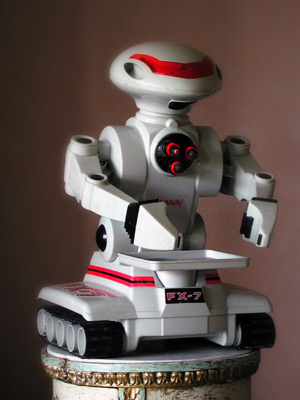French FX-7 robot
| Projects | |
|---|---|

| |
| Participants | Mi1es |
| Skills | Electronics, Soldering, Programming, Creative thinking |
| Status | Active |
| Niche | Electronics |
| Purpose | World domination |
"Contrôle système! Contrôle système!"
Contents
Overview
System
Direct Drive control via RaspPI
Machine has been taken apart.. blblblalbla
H-bridge board has all the transistors of the original board on it for 4 full H-bridges that can drive all of the four bi-directional motors.
Original 'direct drive' Layout was as follows , with the connectors of the motors facing you:
- First block, gpio18, w1, gpio4, w7, Left tread
- Second block, gpio17,w0, gpio23,w4, Right treads
- Third block: gpio27,w2, gpio22,w3, hip
- Fourth block: gpio24, w5, gpio25,w6, arms
'Direct Drive' Python code
import RPi.GPIO as gpio
import time
import pygame
from pygame.locals import *
gpio.setmode(gpio.BOARD)
gpio.setup(7, gpio.OUT)
gpio.setup(11, gpio.OUT)
gpio.setup(13, gpio.OUT)
gpio.setup(15, gpio.OUT)
gpio.output(7, True)
gpio.output(11, True)
while True:
gpio.output(13, True)
gpio.output(15, False)
time.sleep(2)
gpio.output(13, False)
gpio.output(15, True)
time.sleep(2)
pygame.init()
screen = pygame.display.set_mode((640,480))
pygame.display.set_caption("Pygame")
pygame.mouse.set_visible(0)
done = False
enable = 0
direction = 0
while not done:
for event in pygame.event.get():
if(event.type==KEYDOWN):
print event
if(event.key==273):
direction=1;
enable=1;
if(event.key==274):
direction=-1;
enable=1;
if(event.type==KEYUP):
print event
if(event.key==273):
direction=0;
enable=0;
if(event.key==274):
direction=0;
enable=0;
if(enable==1):
if(direction==1):
print "Forwards"
gpio.output(13, False)
gpio.output(15, True)
if(direction==-1):
print "Backwards"
gpio.output(13, True)
gpio.output(15, False)
else:
gpio.output(13, False)
gpio.output(15, False)
With this code-shim you can test the function of your code even without having RPi.GPIO loaded (like on most PC's)
Note it doesnt implement all things yet; but enough to work for this project currently.
Working on a shift-register help-library
class FAKEGPIO:
def __init__(self):
self.BOARD=1
self.OUT=0
self.IN=1
def setmode(self,variant):
print "Call: setmode: variant -> " + str(variant)
def setup(self,pin, type):
print "Call: setup : pin -> " + str(pin) + ", type -> " + str(type)
def output(self,pin,state):
print "Out:" + str(pin) + "-> " + str(state)
gpio = FAKEGPIO()
Shift-Register driving of robot
Since the RaspPI doesnt have much IO and the robot requires 8 output-pins just for the basic motor-control already, we've started looking at driving the outputs using shift-registers instead.
The proto-board has been re-wired to have two shift-registers hosted on it, connected in series, for a total of 16 outputs.
The motor-pins are connected to the first of the two shift-registers; this means that the last 8 bits of data shifted into the 16 bit register-space controls the motors as the first bit shifted in ends up being at the last-most position after 16 clock-cycles.
Shift-register layout
| Shift-register layout | |||||
|---|---|---|---|---|---|
| Register | Bit | Motor | Direction | ||
| 1 | 0 | Left Tread | Forwards | ||
| 1 | Left Tread | Backwards | |||
| 2 | Right Tread | Forwards | |||
| 3 | Right Tread | Backwards | |||
| 4 | Hip | Forwards | |||
| 5 | Hip | Backwards | |||
| 6 | Arms | Open | |||
| 7 | Arms | Close | |||
| 2 | 0 | TBD | TBD | ||
| 1 | TBD | TBD | |||
| 2 | TBD | TBD | |||
| 3 | TBD | TBD | |||
| 4 | TBD | TBD | |||
| 5 | TBD | TBD | |||
| 6 | TBD | TBD | |||
| 7 | TBD | TBD | |||